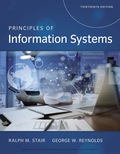
Principles of Information Systems (MindTap Course List)
13th Edition
ISBN: 9781337516945
Author: STAIR
Publisher: Cengage
expand_more
expand_more
format_list_bulleted
Question
Chapter 12, Problem 11DQ
Program Plan Intro
Waterfall model:
- Waterfall model is the first process model in which each phase is completed before starting the next phase.
- It is the first Software Development Life Cycle (SDLC) approach used for developing the software.
- It includes six different types of phases and they are as follows
- Investigation
- The clear understanding of the problems in a system and solving them is performed in investigation phase.
- This helps in developing the project in less time.
- Analysis
- Gathering the data from the existing system and determining the requirements for new systems is done in analysis phase.
- It defines the user requirements and expectations.
- Design
- The existing program or code is executed according to the required design.
- It mainly depends on user requirements.
- Its aim is to convert the user requirements to a complete system.
- Construction
- Construction phase is used to execute the code according to design.
- It is managed by the group of programmers or developers called development team.
- Integration and Testing
- In integration and testing phase, the individual programs or codes are integrated together and tested as group.
- It is used for finding the errors and solving them.
- Implementation
- It is the last phase of the project development process in which development of the project is implemented and maintained.
- It includes user preparation, site preparation, installation and many such.
Agile development process:
- It is an iterative system development approach used for developing the system in terms of sprints.
- It includes the time period from two weeks to two months.
- It includes the communication between users, developers, testers and managers.
- It focuses on the quality of the development of project.
Expert Solution & Answer
Want to see the full answer?
Check out a sample textbook solution
Students have asked these similar questions
using r language
using r language
Compute a Monte Carlo estimate of
0.8
by sampling from Uniform(0,0.8) and estimate the variance of ⑦.
Chapter 12 Solutions
Principles of Information Systems (MindTap Course List)
Ch. 12.2 - Outline the tasks that must be accomplished to...Ch. 12.2 - Following your discussion, one of the team members...Ch. 12.2 - There is likely to be some confusion over the role...Ch. 12.2 - Prob. 2CTQCh. 12.3 - Prob. 1RQCh. 12.3 - Prob. 2RQCh. 12.3 - Prob. 1CTQCh. 12.3 - What other potential problems can you anticipate...Ch. 12.4 - Prob. 1RQCh. 12.4 - Prob. 2RQ
Ch. 12.4 - Prob. 1CTQCh. 12.4 - A safety-critical system is one whose failure or...Ch. 12 - Prob. 1SATCh. 12 - _______________ software can provide a better...Ch. 12 - Prob. 3SATCh. 12 - Prob. 4SATCh. 12 - The purpose of the system investigation phase is...Ch. 12 - ______________ is a diagram used to document the...Ch. 12 - The overall emphasis of the __________ phase is on...Ch. 12 - The primary tool for assessing the software...Ch. 12 - Prob. 9SATCh. 12 - Prob. 10SATCh. 12 - Prob. 11SATCh. 12 - Prob. 12SATCh. 12 - A preliminary evaluation of software packages and...Ch. 12 - Prob. 1RQCh. 12 - Prob. 2RQCh. 12 - Prob. 3RQCh. 12 - Prob. 4RQCh. 12 - Prob. 5RQCh. 12 - What are the key elements of a system...Ch. 12 - Prob. 7RQCh. 12 - Prob. 8RQCh. 12 - Prob. 9RQCh. 12 - Prob. 10RQCh. 12 - Prob. 11RQCh. 12 - Prob. 12RQCh. 12 - Prob. 13RQCh. 12 - Prob. 14RQCh. 12 - An organization has selected and is now...Ch. 12 - Prob. 1DQCh. 12 - Thoroughly discuss the pros and cons of buying...Ch. 12 - Prob. 3DQCh. 12 - Prob. 4DQCh. 12 - Prob. 5DQCh. 12 - Prob. 6DQCh. 12 - Prob. 7DQCh. 12 - Define the Pareto principle, and discuss how it...Ch. 12 - Prob. 9DQCh. 12 - Prob. 10DQCh. 12 - Prob. 11DQCh. 12 - Prob. 12DQCh. 12 - Identify and briefly discuss four key tasks...Ch. 12 - A new sales ordering system needs a relational...Ch. 12 - Prob. 2TACh. 12 - You and your team have been hired to perform a...Ch. 12 - Prob. 1WECh. 12 - Prob. 2WECh. 12 - Do research to determine the current level of...Ch. 12 - Prob. 1CECh. 12 - Prob. 2CECh. 12 - Identify an information system frequently employed...Ch. 12 - It is perhaps not surprising that Etsy was an...Ch. 12 - Prob. 2CTQ1Ch. 12 - What would be some of the criteria you would use...Ch. 12 - Prob. 1CTQ2Ch. 12 - Prob. 2CTQ2Ch. 12 - Prob. 3CTQ2
Knowledge Booster
Similar questions
- Write a C program using embedded assembler with a function to convert a digit (0 – 15) to the corresponding ASCII character representing the value in hexadecimal. For numbers 0 – 9, the output will be the characters '0' – '9', for numbers 10 – 15 the characters 'A' – 'F'. The entire core of the program must be written in symbolic instruction language; arrays may not be used. You may only use C to print the result. Tip: This piece of C program will do the same thing: character = number < 10 ? number + '0' : number + 55; As a basis, you can use this program again , which increments a variable. Just replace the INC instruction with ADD and add a test (CMP) with some conditional jump.arrow_forwardAnswer the question fully and accurately by providing the required files(Java Code, Two output files and written answers to questions 1-3 in a word document)meaning question 1 to 3 also provide correct answers for those questions.(note: this quetion is not graded).arrow_forward.NET Interactive Solving Sudoku using Grover's Algorithm We will now solve a simple problem using Grover's algorithm, for which we do not necessarily know the solution beforehand. Our problem is a 2x2 binary sudoku, which in our case has two simple rules: •No column may contain the same value twice •No row may contain the same value twice If we assign each square in our sudoku to a variable like so: 1 V V₁ V3 V2 we want our circuit to output a solution to this sudoku. Note that, while this approach of using Grover's algorithm to solve this problem is not practical (you can probably find the solution in your head!), the purpose of this example is to demonstrate the conversion of classical decision problems into oracles for Grover's algorithm. Turning the Problem into a Circuit We want to create an oracle that will help us solve this problem, and we will start by creating a circuit that identifies a correct solution, we simply need to create a classical function on a quantum circuit that…arrow_forward
- .NET Interactive Solving Sudoku using Grover's Algorithm We will now solve a simple problem using Grover's algorithm, for which we do not necessarily know the solution beforehand. Our problem is a 2x2 binary sudoku, which in our case has two simple rules: •No column may contain the same value twice •No row may contain the same value twice If we assign each square in our sudoku to a variable like so: 1 V V₁ V3 V2 we want our circuit to output a solution to this sudoku. Note that, while this approach of using Grover's algorithm to solve this problem is not practical (you can probably find the solution in your head!), the purpose of this example is to demonstrate the conversion of classical decision problems into oracles for Grover's algorithm. Turning the Problem into a Circuit We want to create an oracle that will help us solve this problem, and we will start by creating a circuit that identifies a correct solution, we simply need to create a classical function on a quantum circuit that…arrow_forwardAnswer two JAVA OOP problems.arrow_forwardAnswer two JAVA OOP problems.arrow_forward
arrow_back_ios
SEE MORE QUESTIONS
arrow_forward_ios
Recommended textbooks for you
 Principles of Information Systems (MindTap Course...Computer ScienceISBN:9781305971776Author:Ralph Stair, George ReynoldsPublisher:Cengage Learning
Principles of Information Systems (MindTap Course...Computer ScienceISBN:9781305971776Author:Ralph Stair, George ReynoldsPublisher:Cengage Learning Principles of Information Systems (MindTap Course...Computer ScienceISBN:9781285867168Author:Ralph Stair, George ReynoldsPublisher:Cengage Learning
Principles of Information Systems (MindTap Course...Computer ScienceISBN:9781285867168Author:Ralph Stair, George ReynoldsPublisher:Cengage Learning Fundamentals of Information SystemsComputer ScienceISBN:9781337097536Author:Ralph Stair, George ReynoldsPublisher:Cengage Learning
Fundamentals of Information SystemsComputer ScienceISBN:9781337097536Author:Ralph Stair, George ReynoldsPublisher:Cengage Learning Fundamentals of Information SystemsComputer ScienceISBN:9781305082168Author:Ralph Stair, George ReynoldsPublisher:Cengage Learning
Fundamentals of Information SystemsComputer ScienceISBN:9781305082168Author:Ralph Stair, George ReynoldsPublisher:Cengage Learning Information Technology Project ManagementComputer ScienceISBN:9781337101356Author:Kathy SchwalbePublisher:Cengage Learning
Information Technology Project ManagementComputer ScienceISBN:9781337101356Author:Kathy SchwalbePublisher:Cengage Learning Management Of Information SecurityComputer ScienceISBN:9781337405713Author:WHITMAN, Michael.Publisher:Cengage Learning,
Management Of Information SecurityComputer ScienceISBN:9781337405713Author:WHITMAN, Michael.Publisher:Cengage Learning,

Principles of Information Systems (MindTap Course...
Computer Science
ISBN:9781305971776
Author:Ralph Stair, George Reynolds
Publisher:Cengage Learning

Principles of Information Systems (MindTap Course...
Computer Science
ISBN:9781285867168
Author:Ralph Stair, George Reynolds
Publisher:Cengage Learning

Fundamentals of Information Systems
Computer Science
ISBN:9781337097536
Author:Ralph Stair, George Reynolds
Publisher:Cengage Learning

Fundamentals of Information Systems
Computer Science
ISBN:9781305082168
Author:Ralph Stair, George Reynolds
Publisher:Cengage Learning

Information Technology Project Management
Computer Science
ISBN:9781337101356
Author:Kathy Schwalbe
Publisher:Cengage Learning

Management Of Information Security
Computer Science
ISBN:9781337405713
Author:WHITMAN, Michael.
Publisher:Cengage Learning,